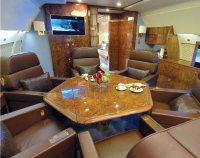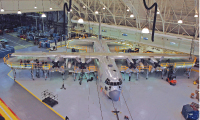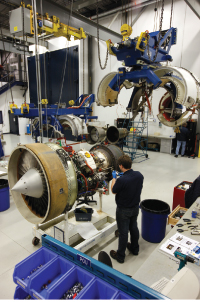
Features
MRO
Slimmed down and shaped up: Standard Aero focuses on aligning cultures and creating awareness
There’s a story told about NASA back in the 1960s. A visitor walked into one of the buildings and saw a man sweeping the floor. He asked the man what he was doing and the worker replied, “I’m sending a man to the moon.”
June 6, 2008 By Stacy Bradshaw
There’s a story told about NASA back in the 1960s. A visitor walked into one of the buildings and saw a man sweeping the floor. He asked the man what he was doing and the worker replied, “I’m sending a man to the moon.”
 |
| The Associated Air Center specializes in VVIP conversions and modifications for BBJ, ACJ and other transport category airplanes. |

|
| C130 at the Ogden Air Force Base. Standard Aero designed and built these maintenance docks as part of the Ogden redesign effort. |
 |
| Standard is currently the largest regional aviation engine maintenance provider in the world, working on fans, turboprops and APUs. |
That’s the type of vision that Andrew Farrant, senior vice-president, marketing and corporate communications at Standard Aero, is working to foster. “The point is that he understood what he was doing in the broader context,” says Farrant, “ and that’s really what we want our employees to recognize.”
Farrant is one of the key players in the recent alignment of the group of businesses that now make up Standard Aero. It was in late March 2008 that Standard Aero completed the integration of Landmark Aviation’s legacy maintenance facilities (formerly Garrett Aviation Services) and launched its new corporate identity.
The new Standard Aero, which now consists of the five legacy Landmark Aviation maintenance facilities and the seven legacy Standard Aero facilities combined, was created when Dubai Aerospace Enterprise (DAE) purchased Standard Aero and Landmark Aviation from the Carlyle Group in July 2007. In February 2008, DAE sold the FBOs and the Landmark name to GTCR, Encore FBO and Platform Partners.
The company is now operating as one unified entity with more than 4,000 employees in the US, Canada, Europe and Asia. Annual sales are $1.4 billion.
Bringing these kinds of entities together is not without its challenges. “This has been much more than simply a corporate identity re-brand,” Farrant explains. “The toughest part of bringing these businesses together is getting the culture aligned.”
The goal is to instil in all employees the brand, vision and values of the company. To accomplish this, the company plans to draw from the history of its predecessor businesses and ensure that important defining characteristics are articulated both internally among employees and externally into the marketplace.
Part of that process involves helping employees see the bigger picture. For example, some employees in the legacy Standard Aero environment actually never see a customer. An engine gets boxed up and shipped to a facility, they fix it and they send it back.
“We want them to think about what they are doing in a much broader way than just fixing an engine,” says Farrant. “Ultimately that engine’s going to fit onto a customer’s product and ultimately they’ve got an opportunity to enhance that customer’s ownership and operating experience and that’s really what we are getting at with the vision.”
The thought process is based on the idea that ‘a brand is synonymous with a company’s reputation.’ “The idea was to take a venerable name like Standard Aero and present it in an updated context and ensure that it is extendable over a broad range of services so that we didn’t end up in a position where we were ‘engine-centric’,” says Farrant.
The company now has five broad markets: business aviation, airlines, services and helicopters, military, and VVIP interior completions.
Business Aviation
For the time being, Standard’s business aviation efforts are largely North American focused. “For us the bizav segment is all about ‘tip to tail,’” says Standard Aero president Paul Soubry. “It’s engines, it’s airframes, it’s avionics, paint, interior refurbs, completions, and so forth.” The company has locations in LA (LAX) Houston (IAH), Augusta (AGS) and Springfield (SPI) and also operates 14 mobile service teams across the continent.
Standard has recently signed with Pratt & Whitney to be the launch service facility for the Pratt 600 VLJ engines. “We are excited about that not only because of the air taxi market but also because of what it means for business aviation,” says Soubry.
Standard wanted to be part of an engine program as early as possible instead of waiting for a large market population to emerge and then competing with everyone else for transaction events. “What we did,” says Soubry, “was team with Pratt & Whitney the minute the engine started being delivered to the marketplace. We have effectively invested and bought into that aftermarket support network from day one.”
Standard believes that it’s now well positioned in this market and is building a new test complex to support the engine over the long term. They’ve set up a facility in Maryville TN, commissioned the operating cell, and have already completed field service and shop events for Pratt.
Airlines and Fleets
“Airlines and fleets will be our fastest growing business,” says Soubry. “ In Winnipeg, we will soon be announcing another expansion of our CF34 shop.” The CF34 is a GE engine found on Bombardier’s CRJ100/-200/-700/-900s, Bombardier’s Challenger 601/604/605s, Embraer’s 170/175/190/195 and the Chinese ACAC ARJ21.
In addition to the CF34, Standard also offers complete engine MRO services for the AE3007, the PW100, the PT6, the PW600 and for Honeywell APUs.
Standard is currently the largest regional aviation engine maintenance provider in the world, working on fans, turboprops and APUs. The company operates facilities in Canada, the US and the Netherlands.
Military Support
Historically, Standard Aero started out by supporting the Canadian military, but that now represents less than five per cent of its sales. The company continues to do work for domestic military as well as foreign militaries. It also provides a combination of MRO services for engines, props and QEC MRO work and has the world’s largest T56 MRO.
In addition to these MRO activities, Standard has an engineering business that sells consulting services, facility transformation, and reliability-centred maintenance to both military and governments. In the consulting business Standard has capability in Canada and the US, and has recently set up a facility in Australia.
Military is the single largest part of Standard’s business, making up roughly 35 per cent of what it does. Its largest customer is the US Department of Defense. Standard does work for the US army, navy, air force and coast guard, both directly as well as through prime contractors such as Lockheed Martin, M7 Aerospace and Sikorsky Aerospace Services.
Services and Helicopters
At the core of Standard’s operation is its services segment. A longtime major player in the helicopter business servicing the RR250, Standard has supported the engine for more than 40 years and boasts the world’s largest Model 250 MRO.
The company has recently acquired TSS Aviation in Cincinnati, which does nothing but component repair and overhaul for large fan engines and industrial engines. “Component repair and overhaul is an area that you will see us growing in,” says Soubry.
VVIP Completions
Considered to be the “sweet spot” of the DAE enterprise, Standard Aero is committed to growing its aircraft completions segment through the Associated Air Center. Acquired when Landmark was owned by the Carlyle Group, Associated Air Center has been operating now for 60 years. Located at the Dallas Love Field in Texas, the company has a full range of completion and modification capabilities on aircraft ranging from Boeing and Airbus business jets to the Boeing 747.
“In the last 10 or so years, the market for BBJs, ACJs and other transport category airplanes being converted for private transport has really taken off,” says Soubry. “It’s a very buoyant part of the market and we have a really unique position in that we support both the Boeing and Airbus fleets.”
Aligning with the OEMs
The most important strategy in Standard’s approach is that its whole business is aligned with the OEMs, meaning that they use their intellectual property, technical data and everything else that follows. At the same time, Standard continues to develop a lot of its own intellectual property.
“The key to Standard’s success at this point,” says Soubry, “is its ability to optimize unique and specific customer solutions. Because we have the benefit of dealing with both OEM programs and fleets, military, regional airlines and so forth, we have been able to take a lot of the learning across these different segments and apply it to our service offerings.”
With the restructuring now complete, Standard Aero is confident that it has the solid strategies and infrastructure required to both grow market share and expand into new markets.
“Any brand is measured on two attributes,” says Farrant, “one is ‘awareness’ and the other is ‘equity.’ Take for example, the ‘Titanic,’ he says, “high on awareness, but low on equity because it sank on its maiden voyage. We have the opposite situation here at Standard, we are very high on equity but we need to improve on awareness.”
That is the task that Standard Aero is now undertaking. Farrant sees Standard Aero as being one of the industry’s best-kept secrets and his goal quite simply is to let the cat out of the bag.